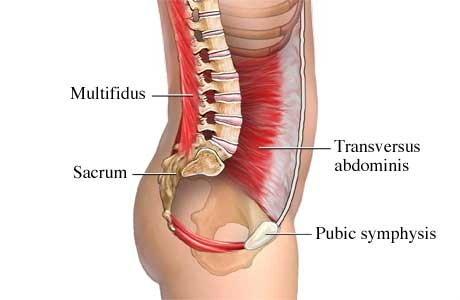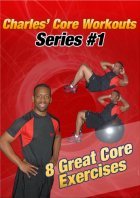Abdominal Muscle Anatomy
Transversus Abdominus
Here's a more in-depth description of the transversus abdominus (tva) for someone who really likes anatomy.
If you are not really familiar with anatomy, read the introduction to abdominal muscle anatomy.
The 4 main muscles of the front of your stomach are the rectus abdominus, the internal obliques, the external oblique muscle, and the transversus abdominus.
The Transverse Ab Muscle originates (starts) on the internal surfaces of the 7th-12th costal cartilages, thoracolumbar fascia, iliac crest, and lateral third of the inguinal ligament, and it inserts (finishes) on the linea alba with the aponeurosis of the internal oblique, pubic crest, and pectin pubis via the conjoint tendon.

It gets its nerve supply from the ventral rami of the inferior six thoracic nerves and the first lumbar nerve.
Its actions are to compress the abdominal contents to stabilize the spine. That's all it does! It's only function is to stablize the spine.
It does not bend or flex or twist or rotate or side bend. When the transverse contracts it tightens the waist, pulls in the belly button and stabilizes the pelvis and lower back.
The Internal Girdle/ Your Natural Weight Belt
The transverse is sometimes referred to as your "Natural Girdle" or your "Internal Weight Belt", and it is widely regarded as the most important abdominal muscle for spinal stability.
It is the deepest of all the anterior abdominal wall muscles which means that it is the closest to the spine, and when you move it is the first of the abdominal muscles to contract.
An important study in biomechanics and muscle coordination was done by Australian physiotherapists. They found that when people without a history of back pain moved their arms, the transversus abdominus would contract to stabilize the lower back before the arm muscles contracted to move the arms.
The body is naturally wired to first be stable around the core before it moves the arms and legs, and the tva is the first muscle that helps to stabilize the lower back before movements.
These researchers also found that people with a history of chronic lower back pain had less coordination in there ab muscles. When people with chronic lower back pain move their arms, the arm muscles contract first and start to move the arm before the transverse contracts to stabilize the lower back.
This lack of coordination is a reason for chronic lower back pain. For some people the natural girdle does not stabilize the spine, and so the spine and joints suffer excess pressure.
The good news for people with chronic lower back pain is that the transverse can be re-trained to work better
to stabilize the spine.
Physical Therapists use the drawing-in maneuver to re-train the transverse.
If you want to have a strong core you should practice the drawing-in maneuver, and remember to pull your belly button to your spine to keep your spine stable.
I hope this helps to give you a better understanding of your natural girdle.
Yours in Health
Charles
Return to Abdominal Muscle Anatomy from the Transversus Abdominus
P.S. Check out my Core Workout Video!
The video can be purchased as DVD's and shipped to your home.
Get the DVD for $7.95 + sph
Click Here to Order Your DVD Today!
Click to learn more about the core training.
My Weight Loss and Fitness Program for Women

Women's Fitness and Weight Loss Program:
Personal Training Secrets to
Lose Belly Fat and Get a Flat Stomach
If you want to lose weight and get a flat stomach, my ebook
Personal Training Secrets to Lose Belly Fat and Get a Flat Stomach is the answer to your prayers.
It's more than just a list of the best ab exercises.
It's a Complete Women's Fitness Plan with Simple Secrets to Lose Weight and Tone Your Stomach.






